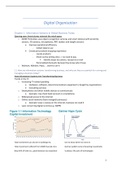Summary
Samenvatting digital organisation + guest houses
- Course
- Institution
- Book
Digital Organisation summary, given by Laura Caluwe in the first semester of the academic year at the University of Antwerp. The summary covers the book, the lessons and the guest lessons.
[Show more]




